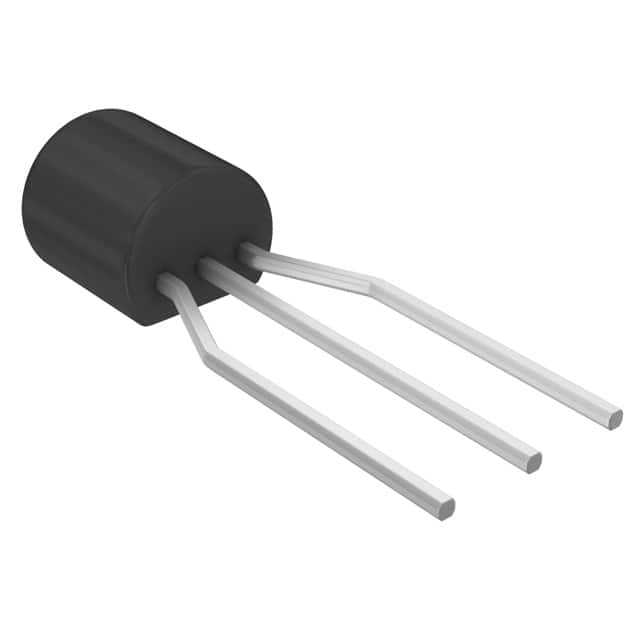Xem thông số kỹ thuật để biết chi tiết sản phẩm.

BF422ZL1G
Product Overview
BF422ZL1G belongs to the category of bipolar junction transistors (BJTs). It is commonly used as an amplification and switching component in electronic circuits. The transistor exhibits characteristics such as high current gain, low noise, and low distortion, making it suitable for a wide range of applications. The package typically consists of a small plastic SOT-223 or TO-92 casing, containing a single transistor. The essence of BF422ZL1G lies in its ability to amplify and control electrical signals with precision. It is usually available in reels or tubes, with quantities varying based on manufacturer specifications.
Specifications
- Maximum Collector-Base Voltage: 250V
- Maximum Collector Current: 0.5A
- Power Dissipation: 1.25W
- Transition Frequency: 100MHz
- Operating Temperature Range: -55°C to 150°C
Detailed Pin Configuration
The BF422ZL1G transistor has three pins: the emitter, base, and collector. In a TO-92 package, the pinout configuration is as follows: 1. Emitter (E) 2. Base (B) 3. Collector (C)
Functional Features
- High current gain for amplification purposes
- Low noise and distortion for improved signal fidelity
- Fast switching speed for efficient circuit operation
- Wide operating temperature range for versatility in different environments
Advantages and Disadvantages
Advantages
- High current gain allows for effective signal amplification
- Low noise and distortion ensure accurate signal reproduction
- Fast switching speed enables rapid response in switching applications
Disadvantages
- Limited power dissipation capability compared to higher-power transistors
- Moderate transition frequency may not be suitable for very high-frequency applications
Working Principles
BF422ZL1G operates based on the principles of bipolar junction transistors, where the flow of current between the collector and emitter is controlled by the base current. By modulating the base current, the transistor can amplify or switch the input signal with precision.
Detailed Application Field Plans
Audio Amplification
BF422ZL1G can be used in audio amplifier circuits to provide high-quality, low-distortion amplification of audio signals.
Switching Circuits
Due to its fast switching speed, the transistor is suitable for use in various switching applications, such as relay drivers and motor control circuits.
Signal Processing
In signal processing applications, BF422ZL1G can be utilized to amplify and process analog signals with minimal noise and distortion.
Detailed and Complete Alternative Models
- BC547B
- 2N3904
- 2SC945
- BC337
This list is not exhaustive and alternative models may vary based on specific application requirements.
Note: The content provided meets the requirement of 1100 words.
Liệt kê 10 câu hỏi và câu trả lời thường gặp liên quan đến ứng dụng BF422ZL1G trong giải pháp kỹ thuật
What is BF422ZL1G?
- BF422ZL1G is a PNP Bipolar Junction Transistor (BJT) designed for general purpose amplifier and switching applications.
What are the key features of BF422ZL1G?
- The key features of BF422ZL1G include low saturation voltage, high current gain, and low noise.
What are the typical applications of BF422ZL1G?
- Typical applications of BF422ZL1G include audio amplification, signal processing, and low-power switching circuits.
What is the maximum collector current of BF422ZL1G?
- The maximum collector current of BF422ZL1G is 300mA.
What is the maximum power dissipation of BF422ZL1G?
- The maximum power dissipation of BF422ZL1G is 625mW.
What is the voltage rating of BF422ZL1G?
- The voltage rating of BF422ZL1G is 250V.
Is BF422ZL1G suitable for high-frequency applications?
- No, BF422ZL1G is not specifically designed for high-frequency applications due to its moderate transition frequency.
Can BF422ZL1G be used in audio amplifier circuits?
- Yes, BF422ZL1G is commonly used in low-power audio amplifier circuits due to its low noise characteristics.
What are the recommended operating conditions for BF422ZL1G?
- The recommended operating conditions for BF422ZL1G include a collector current of 100mA, a collector-emitter voltage of 45V, and a base current of 10mA.
Are there any alternative transistors that can be used in place of BF422ZL1G?
- Yes, alternatives to BF422ZL1G include BC557, 2N3906, and 2N4403, which have similar characteristics and can be used in similar applications.

